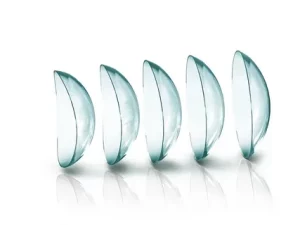Introduction
Contact lenses have become increasingly popular for vision correction, offering convenience and comfort for millions of people worldwide. However, alongside their benefits, there are potential risks associated with wearing contacts that can impact eye health. In this comprehensive guide, we delve into the potential harms wearing contacts may pose to your vision and explore ways to mitigate these risks. Explore More About Health Problems And Their Solutions (Walking pneumonia)
Understanding Contact Lenses
Contact lenses are thin, curved lenses placed directly on the film of tears that covers the surface of your eye. They are primarily used for vision correction in individuals with refractive errors such as nearsightedness, farsightedness, astigmatism, and presbyopia. Contact lenses work by altering the way light enters the eye, focusing it more precisely on the retina to improve vision.

Types of Contact Lenses
There are various types of contact lenses available, including:
1. Soft Contact Lenses
Soft contact lenses are made from flexible plastic materials that allow oxygen to pass through the lens to the cornea. They are comfortable to wear and suitable for individuals with different eye conditions.
2. Rigid Gas Permeable (RGP) Contact Lenses
RGP lenses are made from a firm plastic material that allows oxygen transmission to the cornea. They provide crisp vision but may require an adaptation period due to their rigid nature.
3. Extended Wear Contact Lenses
Extended wear lenses are designed to be worn continuously, even while sleeping. However, they require strict adherence to cleaning and replacement schedules to reduce the risk of eye infections.

Potential Risks of Wearing Contacts
While contact lenses offer vision correction and convenience, wearing them improperly or for extended periods can lead to various eye health issues. Some of the potential risks include:
1. Dry Eyes
Contact lenses can reduce the amount of oxygen reaching the cornea, leading to dryness and discomfort. Prolonged periods of lens wear without breaks can exacerbate this condition and increase the risk of corneal abrasions.
2. Corneal Abrasions
Corneal abrasions are scratches on the surface of the cornea, often caused by improper insertion or removal of contact lenses. These scratches can lead to pain, redness, and sensitivity to light.
3. Infections
Improper handling and cleaning of contact lenses can introduce harmful bacteria and microorganisms to the eyes, increasing the risk of eye infections such as keratitis and conjunctivitis. These infections can cause vision impairment and require prompt medical treatment.
4. Allergic Reactions
Some individuals may develop allergic reactions to contact lens materials or cleaning solutions, resulting in symptoms such as itching, redness, and swelling of the eyes.
Tips for Maintaining Healthy Vision with Contacts
Despite the potential risks, you can minimize the chances of experiencing adverse effects while wearing contact lenses by following these essential tips:
1. Practice Good Hygiene
Always wash your hands with soap and water before handling contact lenses. Additionally, ensure that your lenses are cleaned and disinfected according to your eye care professional’s instructions.

2. Follow Replacement Schedules
Adhere to the recommended replacement schedule for your contact lenses. Using lenses beyond their intended lifespan can increase the risk of eye infections and discomfort.
3. Avoid Sleeping in Lenses
Remove your contact lenses before sleeping, as extended wear can reduce oxygen flow to the cornea and increase the risk of complications such as corneal ulcers.
4. Attend Regular Eye Exams
Schedule routine eye exams with your optometrist to monitor your eye health and ensure your contact lens prescription remains up-to-date. Early detection of any issues can prevent them from escalating into more severe problems.
Soft vs. RGP Contact Lenses
| Aspect | Soft Contact Lenses | RGP Contact Lenses |
|---|---|---|
| Comfort | Highly comfortable for extended wear | May require an adaptation period |
| Oxygen Permeability | Allow high levels of oxygen to reach cornea | Ensure adequate oxygen transmission to the cornea |
| Vision Quality | Suitable for various eye conditions | Provide crisp vision |
| Maintenance | Requires regular cleaning and replacement | Less frequent replacement, but strict cleaning needed |
Conclusion
While contact lenses offer a convenient solution for vision correction, it’s essential to prioritize eye health and minimize potential risks associated with their use. By following proper hygiene practices, adhering to replacement schedules, and attending regular eye exams, you can enjoy clear vision without compromising the health of your eyes. Remember, if you experience any discomfort or vision changes while wearing contact lenses, consult your eye care professional promptly for appropriate guidance and treatment.




